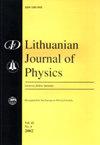智能聚合物中自旋动力学和局部无序的固态核磁共振研究:PDMAEMA
IF 0.3
4区 物理与天体物理
Q4 PHYSICS, MULTIDISCIPLINARY
引用次数: 1
摘要
研究了聚[2-(二甲氨基)甲基丙烯酸乙酯](PDMAEMA)的固态1H和13C NMR谱以及魔角旋转(CP MAS)时1H - 13C交叉极化动力学。PDMAEMA的立体化学含量由CH3基团的13C - MAS络合物信号确定。动力学数据采用Hirschinger和Raya自旋动力学模型进行处理,该模型包含了完整的旋转框架自旋晶格弛豫路径。一般溶液适用于自旋团簇处理。对其季铵化形式之一聚[2-(甲基丙烯氧基)乙基三甲基氯化铵](PMETAC)的CP MAS实验数据进行了重新研究,并应用该模型进行了新的处理。在PDMAEMA和PMETAC中,质子在旋转框架中的自旋晶格弛豫发生在相同的尺度上,从1毫秒到数十毫秒。两种聚合物的自旋扩散各向异性都很高。然而,PDMAEMA中各自旋位点的局部无序性明显高于PMETAC。其阶数参数分别为0.71 ~ 0.77和0.87 ~ 0.91。PDMAEMA的主链也比PMETAC更无序,更灵活。本文章由计算机程序翻译,如有差异,请以英文原文为准。
Solid-state NMR study of spin dynamics and local disorder in smart polymers: PDMAEMA
The solid-state 1H and 13C NMR spectra as well as the 1H–13C cross-polarization upon magic angle spinning (CP MAS) kinetics were studied for poly[2-(dimethylamino)ethyl methacrylate] (PDMAEMA), i.e. a smart pH- and thermo-responsive polymer. The stereochemical content of PDMAEMA was determined from the complex shaped 13C MAS signal of CH3 group. The kinetic data were processed using the Hirschinger and Raya spin dynamics model that includes the complete scheme of rotating frame spinlattice relaxation pathways. The general solution was adapted for the spin cluster treatment. The earlier studied experimental CP MAS kinetics data of poly [2-(methacryloyloxy)ethyl trimethylammonium chloride] (PMETAC), i.e. one of its quaternized form, were revisited and newly processed applying this model. The spin-lattice relaxation of protons in the rotating frame in PDMAEMA and PMETAC occurs in the same scale from one to tens of milliseconds. Very high anisotropy of spin-diffusion was found for both polymers. However, the local disorder of various spin sites in PDMAEMA is significantly higher than in PMETAC. It is characterized by the order parameters 0.71–0.77 and 0.87–0.91, respectively. The main chain in PDMAEMA is also more disordered and more flexible than in PMETAC.
求助全文
通过发布文献求助,成功后即可免费获取论文全文。
去求助
来源期刊

Lithuanian Journal of Physics
物理-物理:综合
CiteScore
0.90
自引率
16.70%
发文量
21
审稿时长
>12 weeks
期刊介绍:
The main aim of the Lithuanian Journal of Physics is to reflect the most recent advances in various fields of theoretical, experimental, and applied physics, including: mathematical and computational physics; subatomic physics; atoms and molecules; chemical physics; electrodynamics and wave processes; nonlinear and coherent optics; spectroscopy.
 求助内容:
求助内容: 应助结果提醒方式:
应助结果提醒方式:


